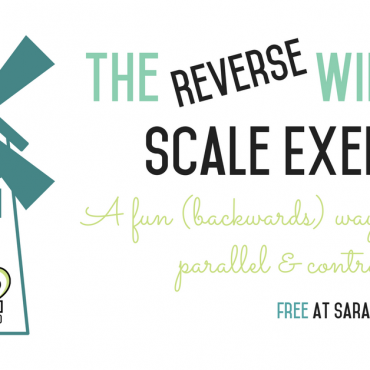[Guest Post] 3 Main Ingredients to Teaching Students To Play By Ear
Today’s post is brought to you by Ruth Power from PianoPicnic.com. She and I recently had a really fun chat in the Upbeat Book Club about teaching students to play by ear. You can find the replay here on YouTube, or you can check it out in the private FB group! Ok… on with the post! ~ Sara
Hi I’m Ruth from PianoPicnic.com! You’re about to feast on my three most essential ingredients to teaching students to play by ear. Expect food-based puns.
Learning songs by ear at a beginner level is about teaching students what to expect.
By covering these three areas you can teach what most songs are made up of (aka the recipe!) so they can make educated guesses instead of stabbing around at notes in the dark!
Here are three ingredients to get your students cooking in self-teaching their favourite popular songs as quickly as possible.
This method is tried & tasted by students of my snackable online course ‘Songs By Ear’.
1. ACTIVE LISTENING
The very first step to playing by ear for any beginner pianist or any pianist that hasn’t delved into this realm before, is to turn the ears on.
We think we listen to music. But most of the time the music we listen to is as a secondary activity in the background.
Passive listening has its place–in this place we can switch off and allow the music to affect us emotionally in the way it is designed to.
But for learning by ear we need ACTIVE LISTENING. This means making a connection with what we hear and what we need to observe.
We ask ourselves questions about how it makes us feel (‘affective’ listening), the instrumentation & form, the movement of the melody, the pulse and characteristics of the rhythm and the changes in harmony.
Each of these layers contribute to our overall understanding of the song and help us to become very familiar with it before we even sit at a piano.
2. CHORD BASICS
At a base level, there are two types of chords that students learning to play by ear need to know: major triads and minor triads.
If you instill in your pianists the ability to build these two chords from anywhere on the piano then they have the ingredients to play a basic arrangement of a vast amount of pop songs.
I start here. And get straight into the songs they can tackle with only these two types of chords.
But you can go as deep as you like, teach the diminished and the augmented, teach 7th chords… but I’ve found that the sooner a song is tackled with the minimum knowledge required, the quicker the student gets that juicy payoff.
Chord basics include an awareness of chord progressions. Introduce the student to the fact that many pop songs only have 3 main chords in the whole song!
Try some 3-chord songs and discuss the idea of where those 3 chords reside in relation to the overall song key! This is the beginning of discussing chord progressions irrespective of the key they’re in: ie I, IV, V.
3. RIFFING TECHNIQUES (OR ‘SPRINKLES’).
The sprinkles that make the chords taste better!
The third aspect of playing by ear at a beginner level is having some different ways of playing those chords to make them spicy.
Solid chords are the starting point. Then explore different ways of breaking up the chords. How many different patterns can your student come up with in 5 minutes?
HINT: Many of their formal repertoire pieces contain broken chord riffs to ‘steal’ and use for playing by ear purposes!
With a foundation of these three elements, a pianist who is beginning to play by ear can teach themselves a basic pop song. What are pop songs if not a smorgasbord of chords? (smorgas-chord?)
When the student has a basic understanding of what makes up a popular* song they have somewhere to begin: a process to apply the formulas they know and explore from there, rather than the overwhelming note-by-note foraging!
*I use popular songs both for studying their commonalities and for learning by ear. Radio-friendly songs are generally formulaic making them a quick and easy study.
Sara here again! I hope you all enjoyed this guest post. Make sure that you subscribe to the blog for regular updates! (Desktop — see top right column. Mobile — scroll down a bit further!) Happy teaching!



![[Guest Post] 3 Main Ingredients to Teaching Students To Play By Ear](https://sarasmusicstudio.com/wp-content/uploads/2018/07/Guest-Post-from-pianopicnic.com-1.png)

